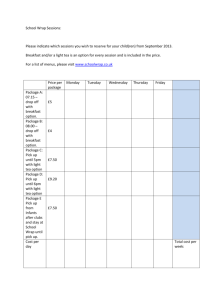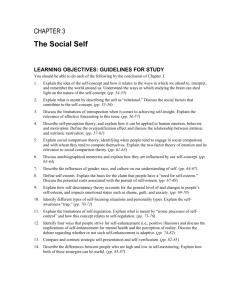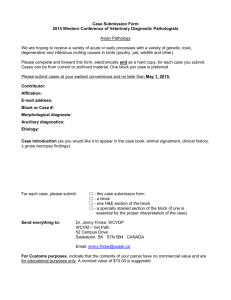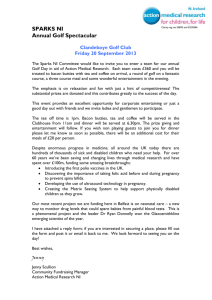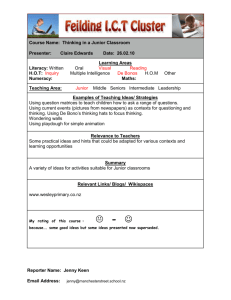Study Guide For Exam # 1
advertisement
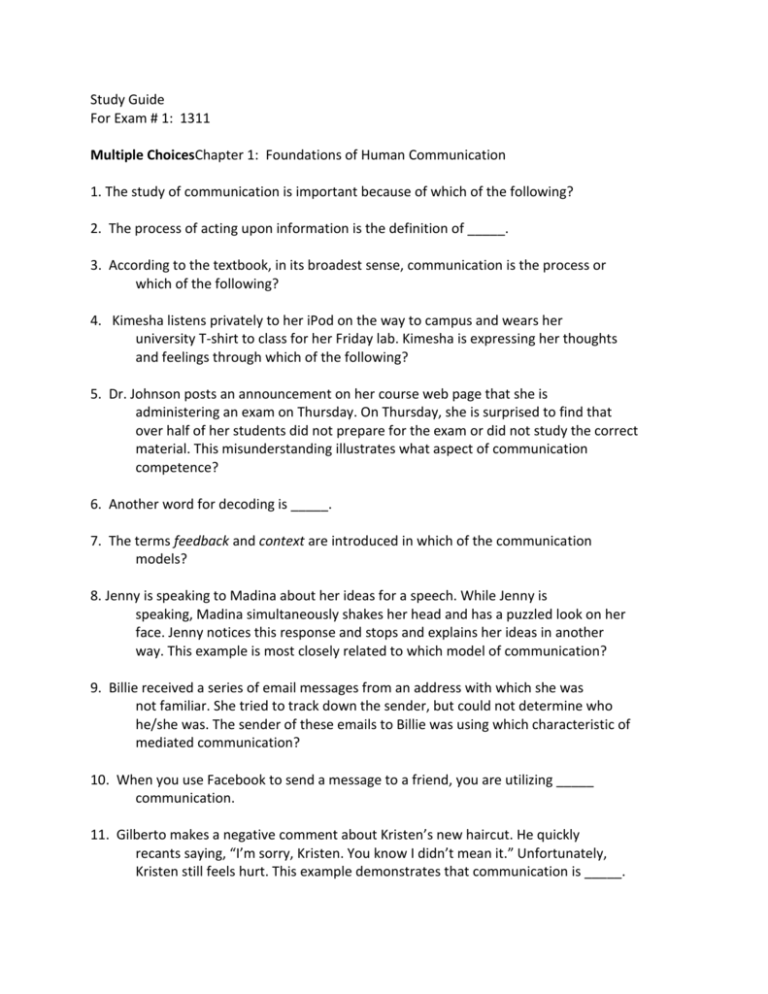
Study Guide For Exam # 1: 1311 Multiple ChoicesChapter 1: Foundations of Human Communication 1. The study of communication is important because of which of the following? 2. The process of acting upon information is the definition of _____. 3. According to the textbook, in its broadest sense, communication is the process or which of the following? 4. Kimesha listens privately to her iPod on the way to campus and wears her university T-shirt to class for her Friday lab. Kimesha is expressing her thoughts and feelings through which of the following? 5. Dr. Johnson posts an announcement on her course web page that she is administering an exam on Thursday. On Thursday, she is surprised to find that over half of her students did not prepare for the exam or did not study the correct material. This misunderstanding illustrates what aspect of communication competence? 6. Another word for decoding is _____. 7. The terms feedback and context are introduced in which of the communication models? 8. Jenny is speaking to Madina about her ideas for a speech. While Jenny is speaking, Madina simultaneously shakes her head and has a puzzled look on her face. Jenny notices this response and stops and explains her ideas in another way. This example is most closely related to which model of communication? 9. Billie received a series of email messages from an address with which she was not familiar. She tried to track down the sender, but could not determine who he/she was. The sender of these emails to Billie was using which characteristic of mediated communication? 10. When you use Facebook to send a message to a friend, you are utilizing _____ communication. 11. Gilberto makes a negative comment about Kristen’s new haircut. He quickly recants saying, “I’m sorry, Kristen. You know I didn’t mean it.” Unfortunately, Kristen still feels hurt. This example demonstrates that communication is _____. 12. The aspect of communication that focuses on WHAT is said, including new information, ideas, and suggested actions, is referred to as _____. 13. Which of the following is an example of intrapersonal communication? 14. Sondra is conscious of her tendency to be soft-spoken and withdrawn in communication situations. Based on this example, what characteristic of a competent communicator does Sondra have? 15. Language consists of _____. 16. Which of the following statements is accurate concerning listening? 17. Which of the following is an attribute of interpersonal communication? 18. Which of the following could best be described as an example of impersonal communication? 19. The textbook describes small group communication as a transactional process among three to fifteen people who 20. Which of the following is an example of presentational communication? Chapter 2: Self Awareness and Communication 1. Danielle is able to observe and reflect upon her own mental states, thus exhibiting 2. Jenny sees herself as a caring person. She communicates this perception of herself to a career counselor; therefore, the counselor recommends that she enter the field of nursing. Jenny’s interaction with the counselor demonstrates what dimension of Jenny’s self-awareness? 3. Maria does not feel confident with her academic abilities in Calculus class; however, she feels at ease with her abilities in her drawing class. This example illustrates which of the following? 4. Brian expresses his dislike for Chinese food. Brian’s dislike demonstrates which component of self-concept? 5. Jaclyn thinks life exists on other planets. This example illustrates which component of self-concept? 6. Which of the following statements most accurately describes the social self? 7. Natasha contemplates her place in the universe, but not from a religious standpoint. Natasha is exploring which component of self? 8. Jose was raised in a Cuban-American community. Although he had many college friends from other co-cultures, he proudly maintained his Cuban roots by sprinkling his speech with Spanish phrases. In addition, he enjoyed sharing examples of cultural norms from his family and neighborhood in his communication class. These examples show which kind of influence on Jose’s self-concept? 9. Priscilla feels that she is unattractive and unlovable following a break-up with her boyfriend. Prior to this incident, Priscilla had a healthy view of her worth. Priscilla experienced a decrease in which of the following? 10. The assessment of your worth or value as reflected in your perceptions of such things as your skills, abilities, appearance and talents is _____. 11. Cindi has lost a good deal of self-esteem because she does not see herself to be as pretty as the girls on television. This may be largely due to which of the following? 12.The statement, “I’m not intelligent because my roommate makes better grades than I do,” illustrates which of the following? 13. Andrew had plans to be married by the age of 25; however, he turned 30 and was still unmarried. He concluded that he was incapable of maintaining a healthy relationship. Andrew’s self-esteem was impacted by which of the following? 14. People can become stressed out because their self-expectations are 15. The idea that what we believe will occur in the future is likely to come true because we believe it will come true is called_____. 16. Edgar wants to develop s healthy self-esteem, so he engages in which of the following? 17. Perception involves _____. 18. The stage of perception in which we put information into patterns is called _____. 19. Assuming a person belongs to a particular group because of his or her clothing is an example of which of the following? 20.Which of the following statements is most accurate concerning stereotypes? Chapter 3: Understanding Verbal Messages 1. The rules and standards that structure language are called_____. 2. A word, sound, gesture, or visual signal that represents a thought, concept, or object is a(n) _____. 3. _____ is a person’s interpretation of a symbol. 4. Bill was visiting his friend Carol’s parents in Chicago. They offered him some tea; he was very thirsty, so he said he would love some. He was very surprised when they brought him a cup of hot tea. In Arkansas where he was from, the word ‘tea’ always meant iced tea. If you wanted a cup of hot tea, you asked for ‘hot tea.’ Which of the following characteristics of language best describes this situation? 5. A learned system of knowledge, behavior, attitudes, beliefs, values, rules, and norms that is shared by a group of people and shaped from one generation to the next is called a _____. 6. Arman wants to be sure that Noshin understands his message, so he uses the dictionary meaning of a particular word. In this case, Arman is using which meaning? 7. If what a word refers to can be experienced with our senses, it is described as _____. 8. When words reflect unqualified, often untrue generalizations that deny individual differences among people, they become the language barrier of _____. 9. Sexist language is also known as _____ language. 10. Bias in language can be directed against _____. 11. Jack announces at the fraternity meeting that there will be a dance next weekend and everyone is invited to bring their girlfriend. This is an example of _____. 12. Generic language is language that _____. 13. The term police officer is an example of _____ language. 14. The term “manual labor” reflects a _____ bias. 15. Polarization is a form of 16. Maddie told Hattie during their discussion on spirituality that Hattie just didn’t “get it” which made Hattie feel disrespected and she became a bit hostile. This is an example of 17. Which of the following would be considered to be a supportive response? 18. When she is angry with Robert, Alice tends to call him a “jerk,” as she storms out of the room. She knows this term gets a response from Robert every time she uses it. The term is an example of a 19. Bafflegab is _____. 20. Pam and Terry were discussing their current relationship. Pam digressed from the current situation and began to talk about what Terry had done in the past to hurt her feelings. This behavior is referred to as _____. Fill in the Blank Chapter 1 1. The beliefs, values, and moral principles by which we determine what is right or wrong are called our _____. 2. The pathway through which messages are sent is the _____. 3. Thoughts, worries, and feelings that distract us from the communication process are called _____. 4. Rules that are not specifically spelled out are _____ rules. 5. Communication that occurs within yourself is referred to as _____ communication. Chapter 2 1. Your _____ identity is one you personally assign to yourself and act out. 2. An evaluation of one’s worth or value that can fluctuate is known as _____. 3. A method for reducing anxiety or boosting your sense of self-esteem by mentally imagining you are performing a particular task in a certain way is _____. 4. The activity involved in perception when we choose specific stimuli in our environment to focus on is _____. 5. A generalization that we apply to persons because we perceive them to have attributes common to a particular group is called a _____. Chapter 3 1. When a person interprets or makes sense of symbols, he or she is creating _____. 2. When people learn a system of knowledge, behavior, attitudes, beliefs, values, rules, and norms that are shared and shaped from one generation to the next, they are learning a _____ . 3.Language that uses general terms that stand for all persons or things within a given category is _____. 4. A(n) _____ climate is one in which people experience trust, caring, and acceptance, and is created through the use of descriptive, empathetic, and/or genuine communication. 5. When you try to put yourself in another person’s shoes and experience what he/she is feeling, you are using _____.

